Effects of Different Aboveground Structural Parts of Grass Strips on the Sediment-Trapping Process
Abstract
1. Introduction
2. Materials and methods
2.1. Experimental Apparatus and Treatments
2.2. Measurement and Data Analysis
2.2.1. Sediment Process Calculations
2.2.2. Hydraulic Parameters
3. Results and Discussions
3.1. Sediment-Trapping Process
3.2. Overland Flow Regime
3.3. Resistances to Overland Flow Provided by the Grass Strips
3.4. Temporal Variations in the Contributions of the Aboveground Parts of the Grass Strips to Sediment Trapping
4. Conclusions
- The aboveground parts of a grass strip can significantly affect the overland flow regime. The slope of the grass strip used in the experiment was 5°. At a flow rate of 30 L min−1 m−1 and a sediment concentration of 120 g L−1, a continuous and high instantaneous sediment-trapping efficiency segment occurred in the initial stage of the complete grass strip experiments. The results indicated that overland flow in the three treatments involved transitional flow and turbulent flow but not laminar flow. Overland flow in the CG (complete grass strip) and RG (green grass removed) group experiments was always tranquil, but critical and supercritical flow occurred in the RGW (green and withered grass removed) group experiments.
- The resistance factor f increased by 0.397 per kilogram of green grass biomass and by 0.418 per kilogram of withered grass biomass (1.05 times higher than f for green grass). The green and withered grass biomass generally determined the resistance to overland flow. The resistances of the aboveground parts of the grass strips to overland flow effectively determined the contributions of the parts to sediment trapping.
- The soil bed surface played a major role in the initial stage of the sediment-trapping process. As the sediment-trapping process continued, green grass became a more important contributor to sediment trapping. In the initial sediment-trapping stage (the first 5 min), the soil bed surface contributed ~90% of the cumulative amount of sediment trapped R(t). In the stable stage, the contributions of green grass, withered grass, and the soil bed surface to R(t) were ~50%, ~20%, and ~30%, respectively. Therefore, more attention should be paid to the role of soil bed surface if local rainfall occurs mainly for short periods. The layout of grass strips and modification of the microtopography can be combined to increase the sediment-trapping performance. For areas with long-duration rainfall, attention should be paid to improving and maintaining grass coverage so grass strips can effectively trap sediment. The vegetation module in some water–sediment models should be designed to fully consider the effects of different aboveground part compositions in the vegetation area.
Author Contributions
Funding
Institutional Review Board Statement
Informed Consent Statement
Data Availability Statement
Acknowledgments
Conflicts of Interest
References
- Hooke, J.; Sandercock, P. Use of vegetation to combat desertification and land degradation: Recommendations and guidelines for spatial strategies in Mediterranean lands. Landsc. Urban Plan. 2012, 107, 389–400. [Google Scholar] [CrossRef]
- Govers, G.; Rauws, G. Transporting capacity of overland flow on plane and on irregular beds. Earth Surf. Process. Landf. 1986, 11, 515–524. [Google Scholar] [CrossRef]
- Singhal, M.K.; Mohan, J.; Agrawal, A.K. Role of grain shear stress in sediment transport. Water Energy Int. 1980, 37, 105–108. [Google Scholar]
- Abrahams, A.D.; Parsons, A.J. Hydraulics of interrill overland flow on stone-covered desert surfaces. Catena 1994, 23, 111–140. [Google Scholar] [CrossRef]
- Comiti, F.; Cadol, D.; Wohl, E. Flow regimes, bed morphology, and flow resistance in self-formed step-pool channels. Water Resour. Res. 2009, 45, 546–550. [Google Scholar] [CrossRef]
- Mekonnen, M.; Keesstra, S.; Stroosnijder, L.; Baartman, J.; Maroulis, J. Soil Conservation through Sediment Trapping: A Review. Land Degrad. Dev. 2015, 26, 544–556. [Google Scholar] [CrossRef]
- Zhou, Z.-C.; Gan, Z.-T.; Shangguan, Z.-P. Sediment Trapping from Hyperconcentrated Flow as Affected by Grass Filter Strips. Pedosphere 2013, 23, 372–375. [Google Scholar] [CrossRef]
- Nyssen, J.; Clymans, W.; Poesen, J.; Vandecasteele, I.; De Baets, S.; Haregeweyn, N.; Naudts, J.; Hadera, A.; Moeyersons, J.; Haile, M.; et al. How soil conservation affects the catchment sediment budget—A comprehensive study in the north Ethiopian highlands. Earth Surf. Process. Landf. 2009, 34, 1216–1233. [Google Scholar] [CrossRef]
- Luo, M.; Pan, C.; Liu, C. Modeling study on the time-varying process of sediment trapping in vegetative filter strips. Sci. Total Environ. 2020, 725, 138361. [Google Scholar] [CrossRef]
- Mekonnen, M.; Keesstra, S.; Ritsema, C.J.; Stroosnijder, L.; Baartman, J. Sediment trapping with indigenous grass species showing differences in plant traits in northwest Ethiopia. Catena 2016, 147, 755–763. [Google Scholar] [CrossRef]
- Akram, S.; Yu, B.; Ghadiri, H.; Rose, C. Modelling Sediment Trapping by Non-Submerged Grass Buffer Strips Using Nonparametric Supervised Learning Technique. J. Environ. Inform. 2015, 27, 1–13. [Google Scholar] [CrossRef][Green Version]
- Farenhorst, A.; Bryan, R. Particle size distribution of sediment transported by shallow flow. Catena 1995, 25, 47–62. [Google Scholar] [CrossRef]
- Rauws, G. Laboratory experiments on resistance to overland flow due to composite roughness. J. Hydrol. 1988, 103, 37–52. [Google Scholar] [CrossRef]
- Einstein, H.A.; Banks, R.B. Fluid resistance of composite roughness. Eos Trans. Am. Geophys. Union 1950, 31, 603–610. [Google Scholar] [CrossRef]
- Weltz, M.A.; Arslan, A.B.; Lane, L.J. Hydraulic Roughness Coefficients for Native Rangelands. J. Irrig. Drain. Eng. 1992, 118, 776–790. [Google Scholar] [CrossRef]
- Ding, L.; Fu, S.; Liu, B.; Yu, B.; Zhang, G.; Zhao, H. Effects of Pinus tabulaeformis litter cover on the sediment transport capacity of overland flow. Soil Tillage Res. 2020, 204, 104685. [Google Scholar] [CrossRef]
- Mu, H.; Yu, X.; Fu, S.; Yu, B.; Liu, Y.; Zhang, G. Effect of stem basal cover on the sediment transport capacity of overland flows. Geoderma 2019, 337, 384–393. [Google Scholar] [CrossRef]
- Jin, C.; Romkens, M.J.M. Experimental Studies of Factors in Determining Sediment Trapping in Vegetative Filter Strips. Trans. ASAE 2001, 44, 277. [Google Scholar] [CrossRef]
- Loch, R.J. Effects of vegetation cover on runoff and erosion under simulated rain and overland flow on a rehabilitated site on the Meandu Mine, Tarong, Queensland. Soil Res. 2000, 38, 299–312. [Google Scholar] [CrossRef]
- Wu, T.; Pan, C.; Li, C.; Luo, M.; Wang, X. A field investigation on ephemeral gully erosion processes under different upslope inflow and sediment conditions. J. Hydrol. 2019, 572, 517–527. [Google Scholar] [CrossRef]
- Nearing, M.A.; Foster, G.R.; Lane, L.J.; Finkner, S.C. A Process-Based Soil Erosion Model for USDA-Water Erosion Prediction Project Technology. Trans. ASAE 1989, 32, 1587–1593. [Google Scholar] [CrossRef]
- Luo, M.; Pan, C.; Liu, C. Experiments on measuring and verifying sediment trapping capacity of grass strips. Catena 2020, 194, 104714. [Google Scholar] [CrossRef]
- Luo, M.; Pan, C.; Cui, Y.; Wu, Y.; Liu, C. Sediment particle selectivity and its response to overland flow hydraulics within grass strips. Hydrol. Process. 2020, 34, 5528–5542. [Google Scholar] [CrossRef]
- Yun, L.; Bi, H.; Gao, L.; Zhu, Q.; Ma, W.; Cui, Z.; Wilcox, B. Soil Moisture and Soil Nutrient Content in Walnut-Crop Intercropping Systems in the Loess Plateau of China. Arid. Land Res. Manag. 2012, 26, 285–296. [Google Scholar] [CrossRef]
- Mehta, N.; Pandya, N.R.; Thomas, V.O.; Krishnayya, N.S.R. Impact of rainfall gradient on aboveground biomass and soil organic carbon dynamics of forest covers in Gujarat, India. Ecol. Res. 2014, 29, 1053–1063. [Google Scholar] [CrossRef]
- Saleh, I.; Kavian, A.; Roushan, M.H.; Jafarian, Z. The efficiency of vegetative buffer strips in runoff quality and quantity control. Int. J. Environ. Sci. Technol. 2018, 15, 811–820. [Google Scholar] [CrossRef]
- Pan, C.; Shangguan, Z. Runoff hydraulic characteristics and sediment generation in sloped grassplots under simulated rainfall conditions. J. Hydrol. 2006, 331, 178–185. [Google Scholar] [CrossRef]
- Li, G.; Abrahams, A.D.; Atkinson, J.F. Correction Factors in the Determination of Mean Velocity of Overland Flow. Earth Surf. Process. Landf. 1996, 21, 509–515. [Google Scholar] [CrossRef]
- Luk, S.H.; Merz, W. Use of the salt tracing technique to determine the velocity of overland flow. Soil Technol. 1992, 5, 289–301. [Google Scholar] [CrossRef]
- Smith, M.; Cox, N.J.; Bracken, L. Applying flow resistance equations to overland flows. Prog. Phys. Geogr. 2007, 31, 363–387. [Google Scholar] [CrossRef]
- Zhang, G.-H.; Wang, L.-L.; Tang, K.-M.; Luo, R.-T.; Zhang, X.C. Effects of sediment size on transport capacity of overland flow on steep slopes. Hydrol. Sci. J. 2011, 56, 1289–1299. [Google Scholar] [CrossRef]
- Nicosia, A.; Di Stefano, C.; Pampalone, V.; Palmeri, V.; Ferro, V.; Polyakov, V.; Nearing, M. Testing a theoretical resistance law for overland flow under simulated rainfall with different types of vegetation. Catena 2020, 189, 104482. [Google Scholar] [CrossRef]
- Emmett, W.W. The Hydraulics of Overland Flow on Hillslopes. 1970. Available online: https://pubs.er.usgs.gov/publication/pp662A (accessed on 6 June 2021). [CrossRef]
- Pan, C.; Ma, L.; Wainwright, J.; Shangguan, Z. Overland flow resistances on varying slope gradients and partitioning on grassed slopes under simulated rainfall. Water Resour. Res. 2016, 52, 2490–2512. [Google Scholar] [CrossRef]
- Nearing, M.A.; Polyakov, V.O.; Nichols, M.H.; Hernandez, M.; Li, L.; Zhao, Y.; Armendariz, G. Slope–velocity equilibrium and evolution of surface roughness on a stony hillslope. Hydrol. Earth Syst. Sci. 2017, 21, 3221–3229. [Google Scholar] [CrossRef]
- Nicosia, A.; Di Stefano, C.; Pampalone, V.; Palmeri, V.; Ferro, V.; Nearing, M.A. Testing a theoretical resistance law for overland flow on a stony hillslope. Hydrol. Process. 2020, 34, 2048–2056. [Google Scholar] [CrossRef]
- Zheng, F.; Bai, H.; An, S. The benefit analysis for different layers of grass vegetation reducing surface runoff and sediment yield. Res. Soil Water Conserv. 2005, 12, 86–87, 111. [Google Scholar]
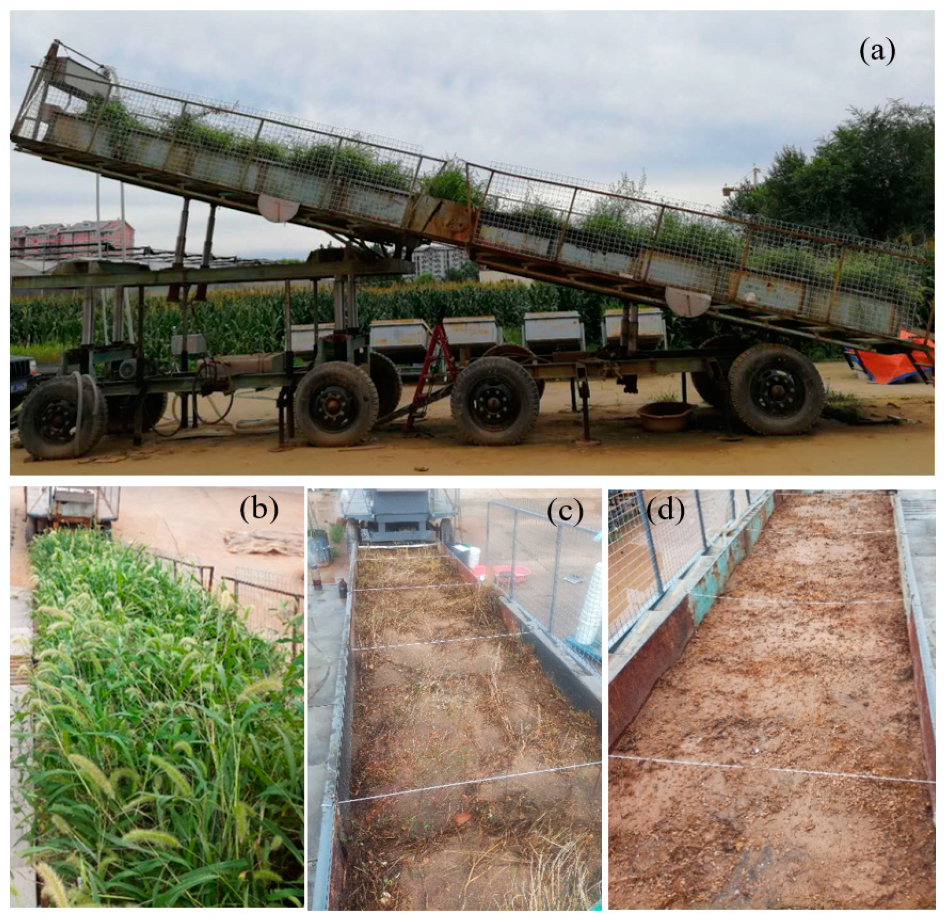
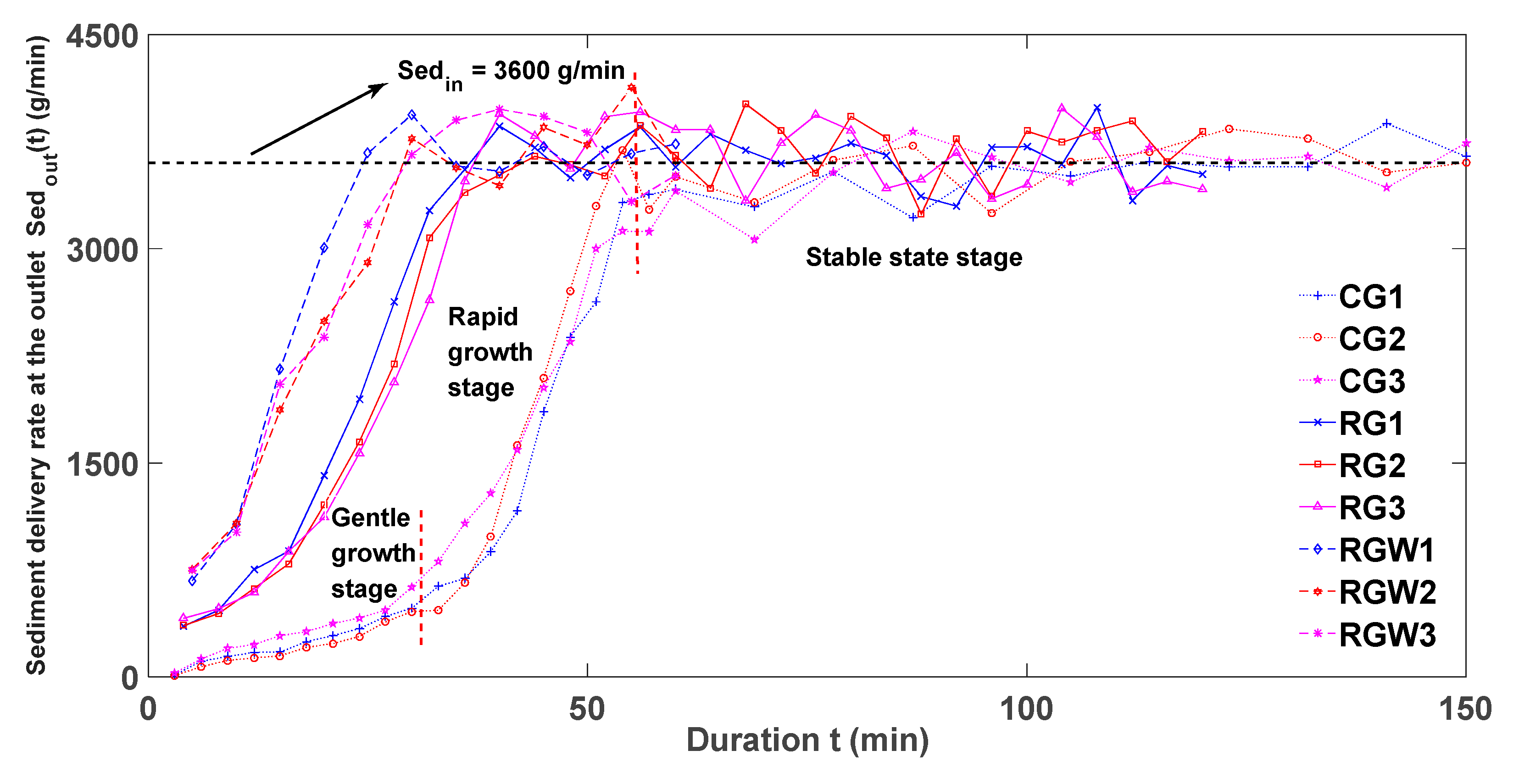
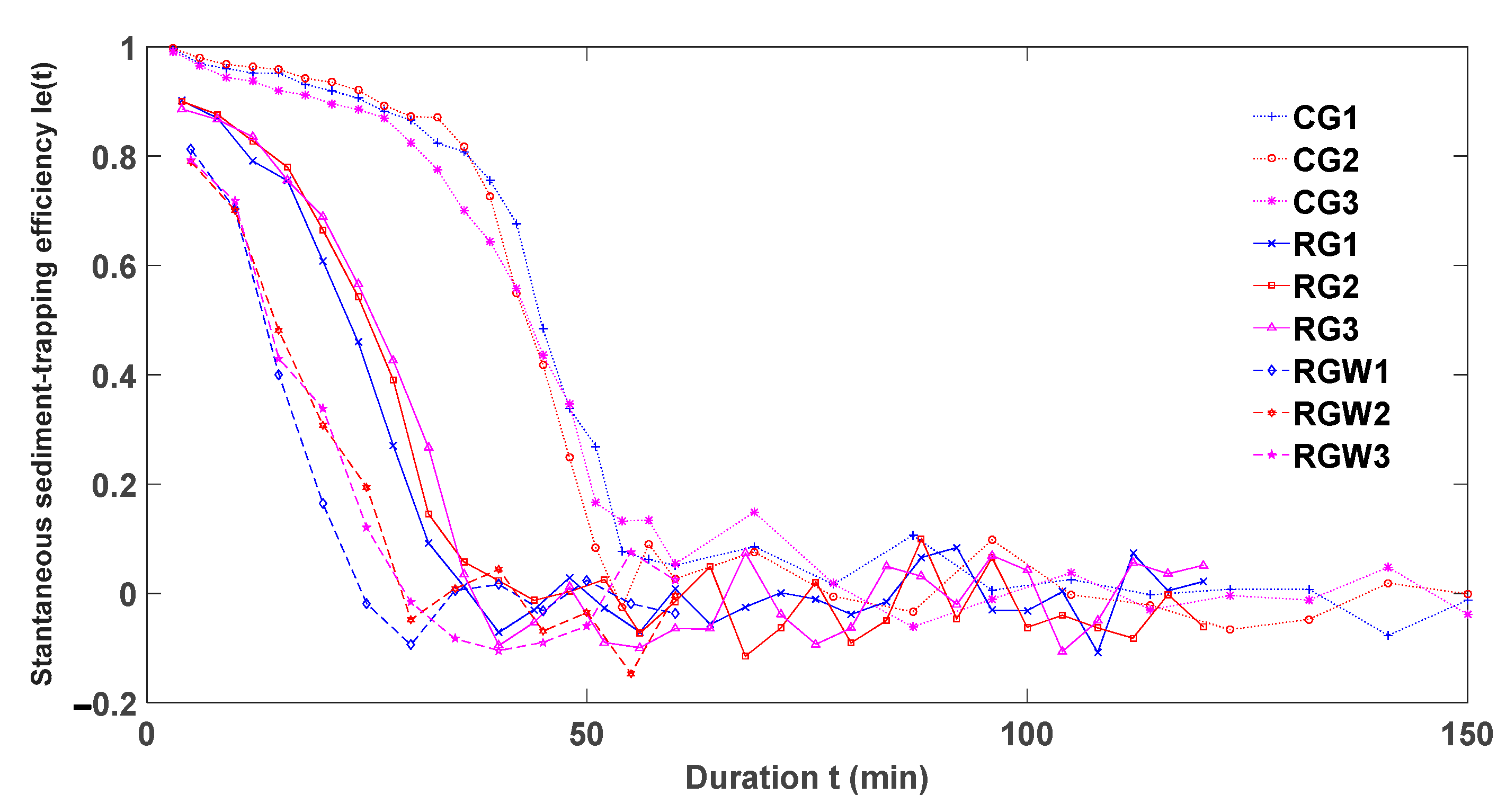
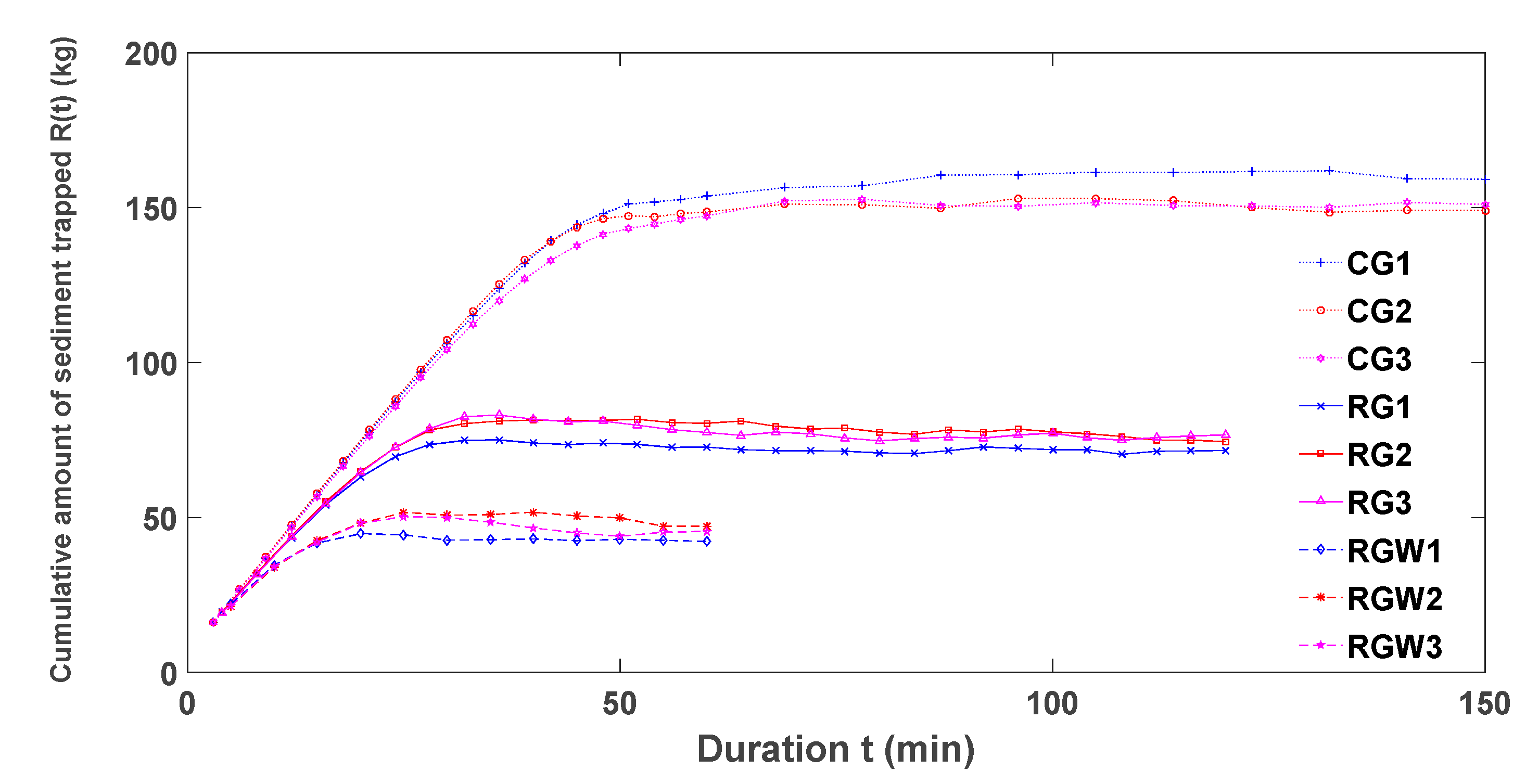
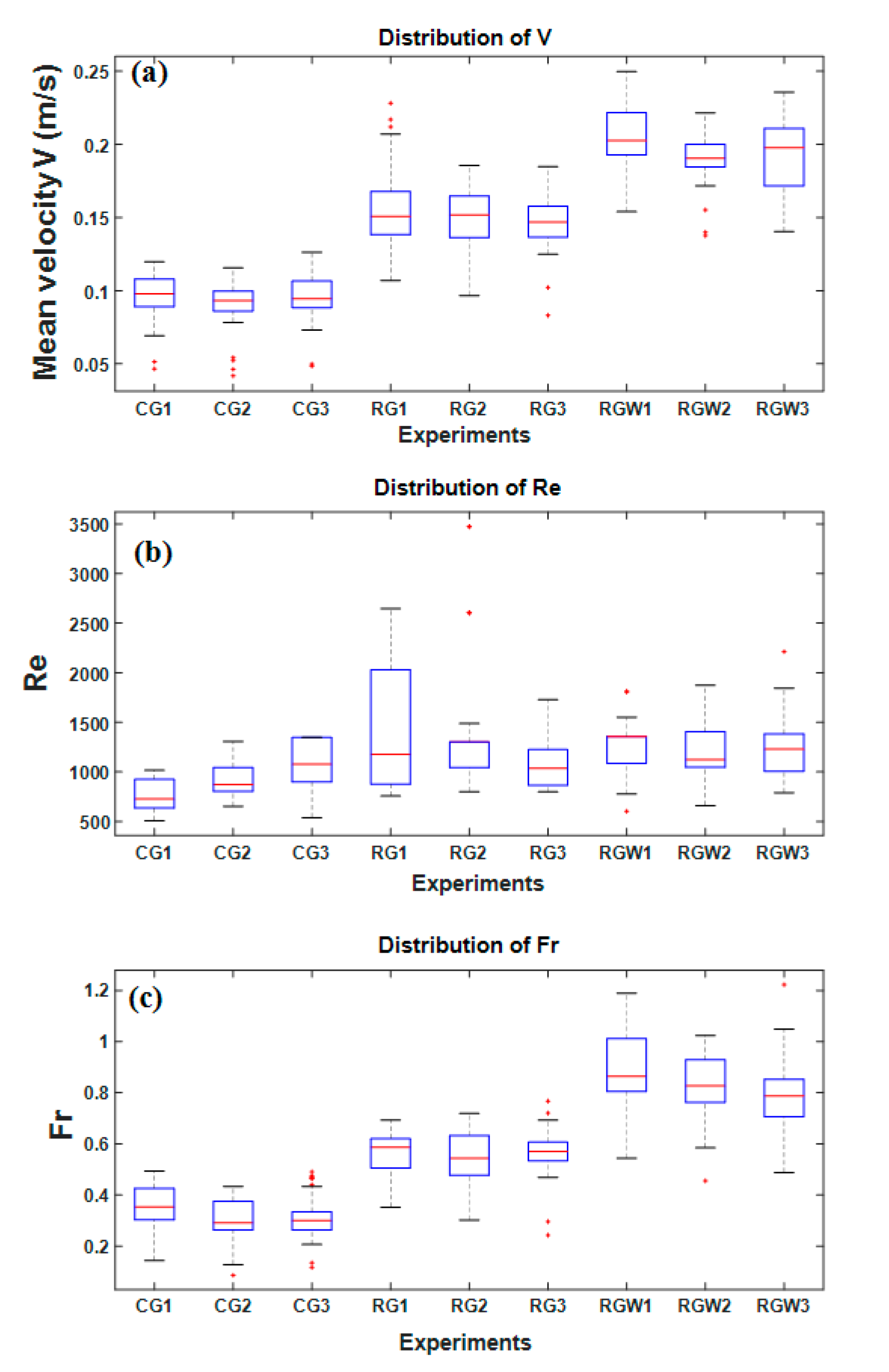
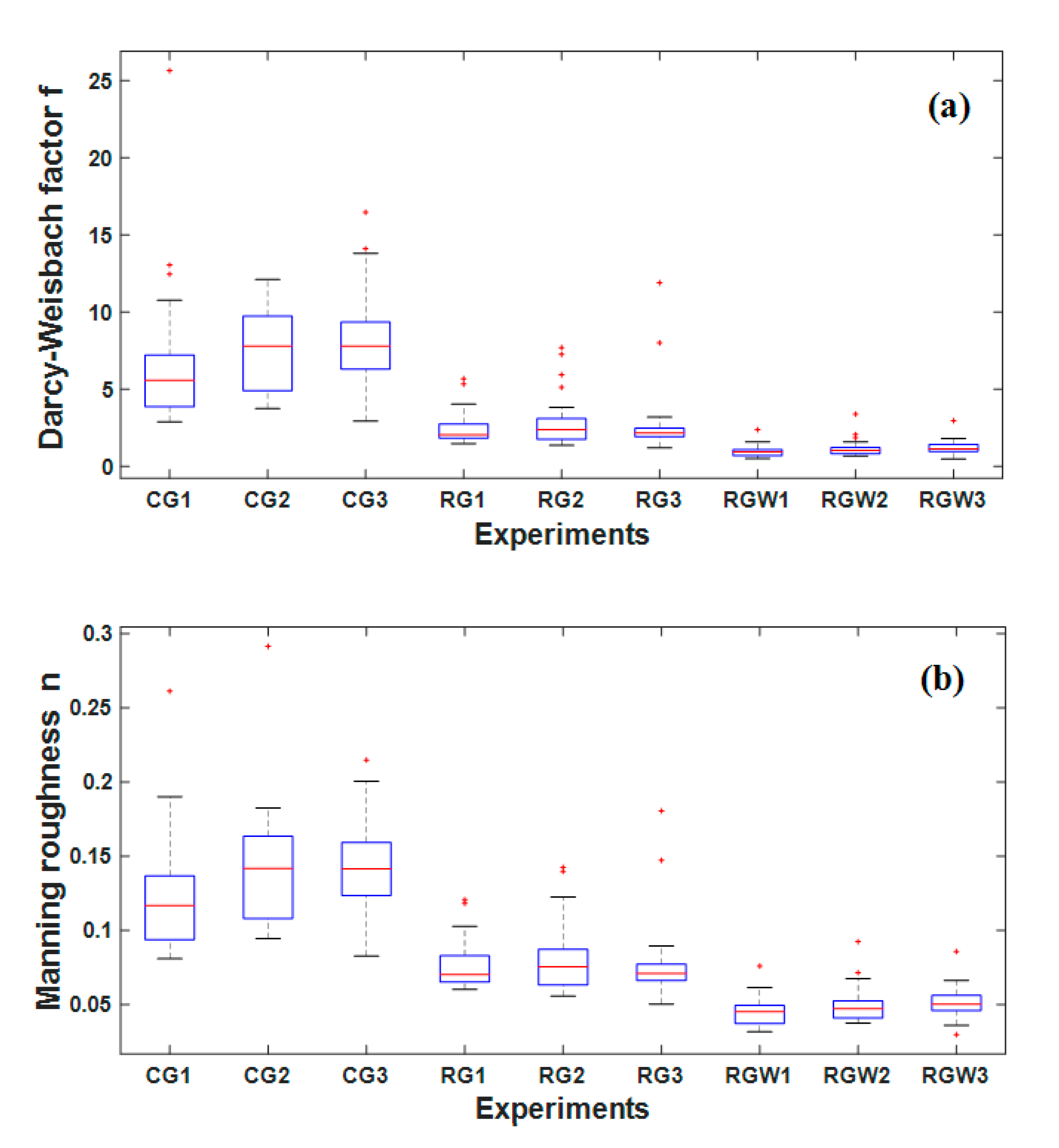
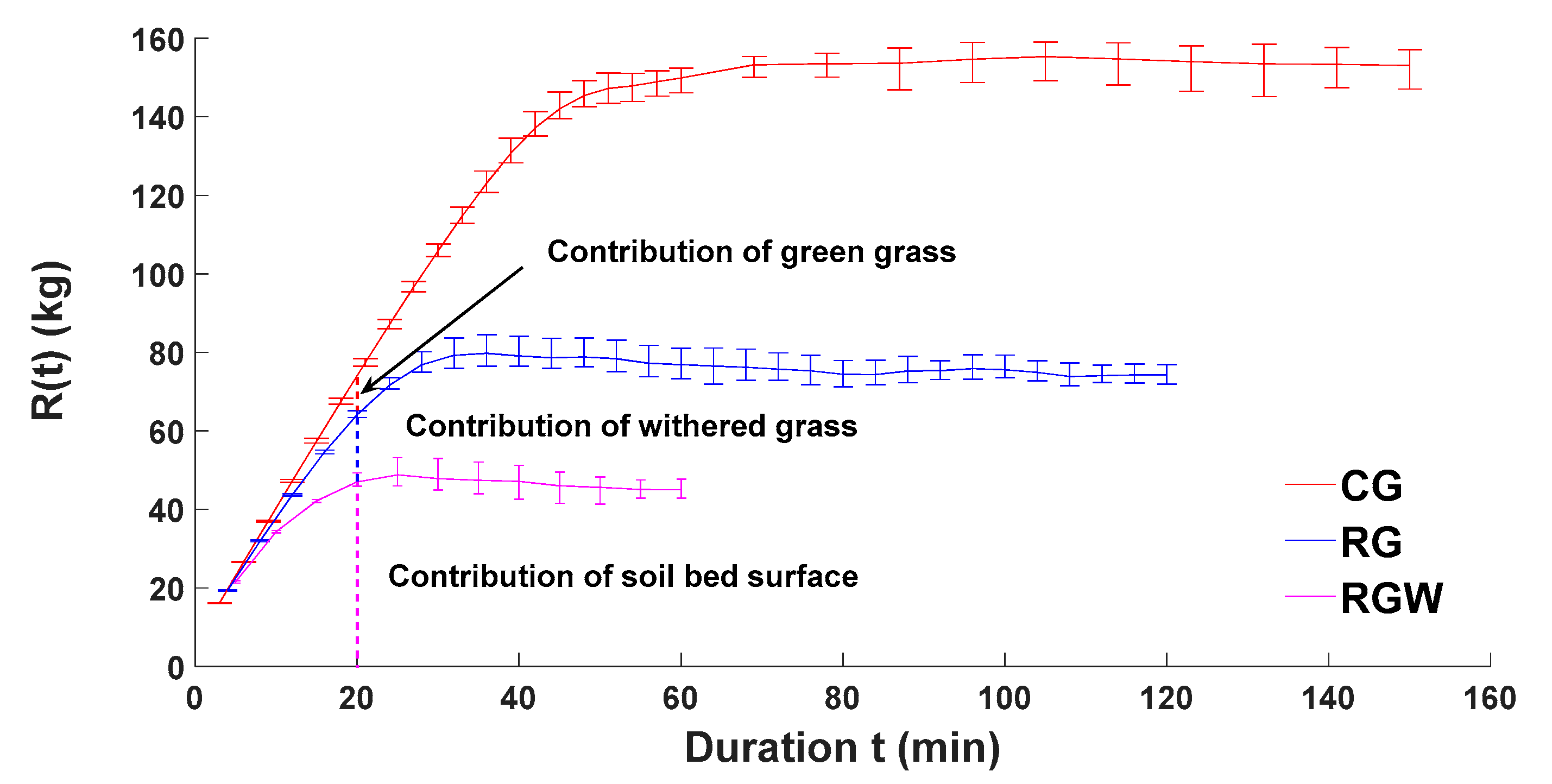
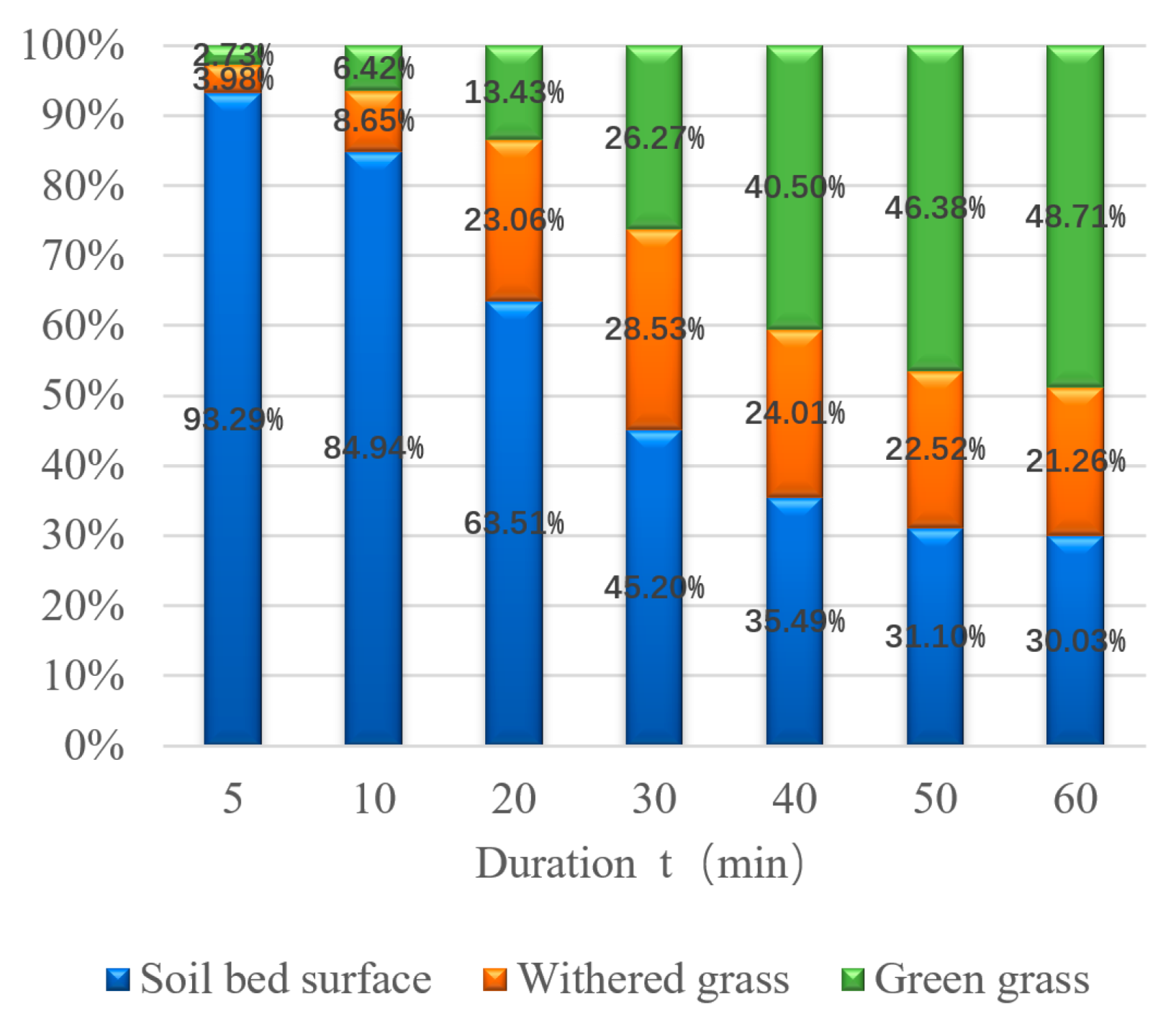
| Particle Size Distribution | Soil Type | Soil Texture | |||||||||
|---|---|---|---|---|---|---|---|---|---|---|---|
| Particle size (μm) | >1000 | 1000–500 | 500–250 | 250–100 | 100–50 | 50–20 | 20–2 | 2–1 | <1 | Loessial soil | Sandy loam soil |
| Percentage (%) | 0 | 0.55 ±0.34 | 1.14 ±0.07 | 5.27 ±1.48 | 29.15 ±2.73 | 46.04 ±1.43 | 15.32 ±2.15 | 0.87 ±0.11 | 1.66 ±0.14 | ||
| Flow Rate (Q) | Sediment Concentration (SC) | Slope | Treatment (Code) | Duration t (min) | Repeated |
|---|---|---|---|---|---|
| 30 L min−1 m−1 | 120 g L−1 | 5° | Completed grass strips (CG) | 150 | 3 |
| Remove green grass (RG) | 120 | 3 | |||
| Remove green and withered grass (RGW) | 60 | 3 |
| Treatment | Experiment Code | V (m/s) | Re | Fr |
|---|---|---|---|---|
| Completed grass strips (CG) | CG1 | 0.047~0.120 | 508~1016 | 0.14~0.49 |
| CG2 | 0.042~0.116 | 653~1306 | 0.09~0.43 | |
| CG3 | 0.049~0.126 | 539~1346 | 0.12~0.49 | |
| Remove green grass (RG) | RG1 | 0.107~0.228 | 756~2647 | 0.35~0.69 |
| RG2 | 0.097~0.186 | 802~3474 | 0.30~0.72 | |
| RG3 | 0.083~0.185 | 798~1730 | 0.24~0.78 | |
| Remove green and withered grass (RGW) | RGW1 | 0.154~0.250 | 603~1809 | 0.54~1.19 |
| RGW2 | 0.138~0.221 | 660~1871 | 0.46~1.02 | |
| RGW3 | 0.141~0.236 | 790~2212 | 0.49~1.22 |
Publisher’s Note: MDPI stays neutral with regard to jurisdictional claims in published maps and institutional affiliations. |
© 2021 by the authors. Licensee MDPI, Basel, Switzerland. This article is an open access article distributed under the terms and conditions of the Creative Commons Attribution (CC BY) license (https://creativecommons.org/licenses/by/4.0/).
Share and Cite
Luo, M.; Pan, C.; Cui, Y.; Guo, Y.; Wu, Y. Effects of Different Aboveground Structural Parts of Grass Strips on the Sediment-Trapping Process. Sustainability 2021, 13, 7591. https://doi.org/10.3390/su13147591
Luo M, Pan C, Cui Y, Guo Y, Wu Y. Effects of Different Aboveground Structural Parts of Grass Strips on the Sediment-Trapping Process. Sustainability. 2021; 13(14):7591. https://doi.org/10.3390/su13147591
Chicago/Turabian StyleLuo, Mingjie, Chengzhong Pan, Yongsheng Cui, Yahui Guo, and Yun Wu. 2021. "Effects of Different Aboveground Structural Parts of Grass Strips on the Sediment-Trapping Process" Sustainability 13, no. 14: 7591. https://doi.org/10.3390/su13147591
APA StyleLuo, M., Pan, C., Cui, Y., Guo, Y., & Wu, Y. (2021). Effects of Different Aboveground Structural Parts of Grass Strips on the Sediment-Trapping Process. Sustainability, 13(14), 7591. https://doi.org/10.3390/su13147591







